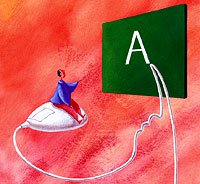Digital Diversity: Engaging All Students in Education
High tech tools shift from special to universal.

Access-enhancing technology -- long seen as a tool exclusively for special-needs students -- will become more widely adapted in the coming year as a means of personalizing instruction for all learners. Reenvisioning uses for targeted technology, and the redefinition of what constitutes a special need, already have begun.
Froma Cummings, director of assistive technology and textbook accessibility for the Arizona Department of Education, saw this coming as she witnessed a familiar scenario in her state's schools: A child with a disability is included in a mainstream classroom, the general education teacher there uses technological tools to help the student access the standard curriculum, and, sooner or later, the teacher realizes, "Wait a sec -- this gizmo that helps Jenny overcome her reading disability could really help these other five children who are struggling to keep up in the novel we're reading, and these other six who are just learning English."
Take, for example, IntelliTools's IntelliKeys keyboard, whose touch-sensitive pad can be tailored to show large-type or pictorial keys. The tool debuted in the special education market, Cummings says, but now is used for nondisabled students who struggle with conventional keyboards. Even in the ubiquitous Microsoft Word software, text-to-speech tools and summarizing functions (which help students draw themes from text) provide multiple entry points into content for students with varied strengths and weaknesses. The explosion of educational software and hardware offers something to accommodate just about every learning style.
The integration of "universally designed technology" (the current term for products designed to be accessible to people with diverse needs) has been slow going across the country; consultant Lisa Wahl estimates that schools typically use only 10 percent of the capabilities of the technology they have. But it's getting a boost this year from a little-heralded federal law called the National Instructional Materials Accessibility Standard (NIMAS). This piece of the Individuals with Disabilities Education Act of 2004 mandates that, beginning August 18, 2006, all publishers provide a digital version of every textbook they sell. The digital format the law requires, XML, will allow states, resource centers, and other entities to manipulate almost any kind of content (text, audio, video, image) into almost any kind of format (excerpts, text-to-speech, Braille, and various fonts) on any platform (computer, Web site, cell phone, PDA).
David Rose, director of the education-technology research group CAST, which helped design NIMAS, expects the first XML books to debut this school year, as scheduled. He predicts that the landmark law will produce only small ripples at first, benefiting the most severely disabled students. "Over the longer term, however," Rose says, "NIMAS will foreshadow a sea change in publishing and teaching. Teachers will come to expect, and then demand, materials that are flexible enough to meet the challenge of the diversity in all their students."